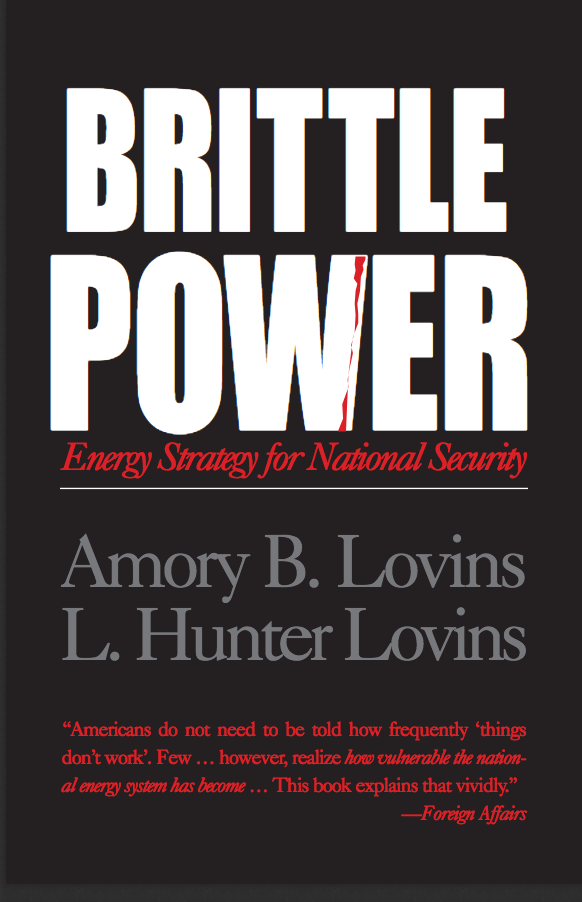|
Bioneers podcast:
"Security by Design" David Orr | Amory Lovins |
"The United States has for decades been undermining the foundations of its own strength. It has gradually built up an energy system prone to sudden, massive failures with catastrophic consequences.
The energy that runs America is brittle—easily shattered by accident or malice. That fragility frustrates the efforts of our Armed Forces to defend a nation that literally can be turned off by a handful of people. It poses, indeed, a grave and growing threat to national security, life, and liberty..." |
There are many reasons why the Trump administration's recent move to force grid operators to buy coal and nuclear power is a catastrophically bad idea: It will distort markets, cost rate-payers tens of billions of dollars, reduce consumer spending power, make US business less competitive and discourage investment in better, cleaner technologies and jobs. It will also make the US more vulnerable to attack. To justify such a move under the cover of "economic and national security" is Orwellian Newspeak at its finest. In "Great Again" America, danger is safety.
There are two kinds of threats—one slow, one fast, both devastating. First there are the many consequences of man-mediated climate change. The accelerating rise in atmospheric carbon levels warming both air and water have quickened the melting of polar ice caps and glaciers, while also causing water itself to expand (warmer seas are bigger seas.) Dozens of US military bases around the world are already battling sea level rise and the expense of moving mission-critical assets to higher ground. Extreme weather events have also become more common, with cascading national security implications:
"...In the Arctic, the region warming faster than anywhere else on Earth, the combination of melting sea ice, thawing permafrost and sea-level rise is eroding the Alaska shoreline enough to damage several Air Force radar early warning and communication installations. At one base, half a runway has given way to erosion, preventing large planes from using it. Damage to a seawall has allowed waves to wash onto the runway at another base. Thawing permafrost has also affected access to training areas.
In the West, drought has amplified the threat of wildfires and deluge has damaged roads, runways, and buildings at bases there. Wildfire in Alaska has interrupted training. Last year in California, fires threatened Camp Pendleton, the Marine Corps’ major West Coast base, which lies 48 miles north of San Diego, as well as Vandenberg Air Force Base, 65 miles north of Santa Barbara. A year’s worth of rain fell in 80 minutes at Fort Irwin in the Mojave Desert in California, causing $64 million in damage to 160 buildings, including barracks, roads, a bridge, and 11,000 feet of fencing..." — Who's Still Fighting Climate Change? The U.S. Military | National Geographic
The mandate that more coal be burned literally adds fuel to the climate change fire, dramatically increasing the risks and costs of socio-political destabilization due to droughts, floods and temperature extremes. We are just beginning to see the first waves of climate refugees.
The second threat is structural. Large central power plants require a large and complex grid to deliver electricity. This is both wasteful (about 2/3's of power generated by coal, for example, is lost as heat in production and delivery) and also a strategic weakness. When something as commonplace as as a tree falling on power line or lightning damaging a transformer during a storm can knock out electricity in a neighborhood for hours (or, in the case of Puerto Rico, for months), it's clear there's a problem. Now imagine an enemy deliberately interrupting the nation's power supply via cyberattack. The grid is under constant siege. Yet at the same time that the administration has imposed sanctions on Russian hackers, whose attacks so far have included at least one nuclear plant, there has also been an exodus of cybersecurity experts from the executive branch.
Malicious code is not the only threat. A strategically placed, low-tech explosive could do extensive damage, especially if nuclear power were the cross-hairs. In fact, grid vulnerability has been a top-level concern of the US military for the last several decades.
The antidote to "brittle power"— a term coined by Amory and Hunter Lovins, co-founders of Rocky Mountain Institute, and the title of a detailed report they prepared for the Pentagon in 1981—is to reimagine the big grid as a series of "islandable" microgrids, preferably powered by clean renewables and improved by efficiency. A modular design means that if one part of the system were damaged, it could be disconnected from the rest of the system during repairs. Each microgrid is self-sufficient so could continue to supply electricity to its users.
In the wake of a disaster, it can be both faster and cheaper to get renewable power sources back online. After Superstorm Sandy decimated the Jersey Shore, for example, many residential solar panels were still physically functional, but due to regulatory requirements were unable to operate independent of the grid. Changing the rules would boost resilience dramatically. It was a teachable moment.
More recently, in Australia a Tesla Powerwall battery storage system for a wind farm was able to keep the local grid up and running when a coal plant went offline. Typically, another coal plant would fire up to supply power in the interim, a process that can take a half hour or more. The Powerwall sensed the outage instantly, saving time and money, with a bonus of no planet-warming emissions. Businesses that depended on the power never skipped a beat, so they saved money, too.
In short, we know how do better. We deserve better. And as it turns out, our national security depends on it.
There are two kinds of threats—one slow, one fast, both devastating. First there are the many consequences of man-mediated climate change. The accelerating rise in atmospheric carbon levels warming both air and water have quickened the melting of polar ice caps and glaciers, while also causing water itself to expand (warmer seas are bigger seas.) Dozens of US military bases around the world are already battling sea level rise and the expense of moving mission-critical assets to higher ground. Extreme weather events have also become more common, with cascading national security implications:
"...In the Arctic, the region warming faster than anywhere else on Earth, the combination of melting sea ice, thawing permafrost and sea-level rise is eroding the Alaska shoreline enough to damage several Air Force radar early warning and communication installations. At one base, half a runway has given way to erosion, preventing large planes from using it. Damage to a seawall has allowed waves to wash onto the runway at another base. Thawing permafrost has also affected access to training areas.
In the West, drought has amplified the threat of wildfires and deluge has damaged roads, runways, and buildings at bases there. Wildfire in Alaska has interrupted training. Last year in California, fires threatened Camp Pendleton, the Marine Corps’ major West Coast base, which lies 48 miles north of San Diego, as well as Vandenberg Air Force Base, 65 miles north of Santa Barbara. A year’s worth of rain fell in 80 minutes at Fort Irwin in the Mojave Desert in California, causing $64 million in damage to 160 buildings, including barracks, roads, a bridge, and 11,000 feet of fencing..." — Who's Still Fighting Climate Change? The U.S. Military | National Geographic
The mandate that more coal be burned literally adds fuel to the climate change fire, dramatically increasing the risks and costs of socio-political destabilization due to droughts, floods and temperature extremes. We are just beginning to see the first waves of climate refugees.
The second threat is structural. Large central power plants require a large and complex grid to deliver electricity. This is both wasteful (about 2/3's of power generated by coal, for example, is lost as heat in production and delivery) and also a strategic weakness. When something as commonplace as as a tree falling on power line or lightning damaging a transformer during a storm can knock out electricity in a neighborhood for hours (or, in the case of Puerto Rico, for months), it's clear there's a problem. Now imagine an enemy deliberately interrupting the nation's power supply via cyberattack. The grid is under constant siege. Yet at the same time that the administration has imposed sanctions on Russian hackers, whose attacks so far have included at least one nuclear plant, there has also been an exodus of cybersecurity experts from the executive branch.
Malicious code is not the only threat. A strategically placed, low-tech explosive could do extensive damage, especially if nuclear power were the cross-hairs. In fact, grid vulnerability has been a top-level concern of the US military for the last several decades.
The antidote to "brittle power"— a term coined by Amory and Hunter Lovins, co-founders of Rocky Mountain Institute, and the title of a detailed report they prepared for the Pentagon in 1981—is to reimagine the big grid as a series of "islandable" microgrids, preferably powered by clean renewables and improved by efficiency. A modular design means that if one part of the system were damaged, it could be disconnected from the rest of the system during repairs. Each microgrid is self-sufficient so could continue to supply electricity to its users.
In the wake of a disaster, it can be both faster and cheaper to get renewable power sources back online. After Superstorm Sandy decimated the Jersey Shore, for example, many residential solar panels were still physically functional, but due to regulatory requirements were unable to operate independent of the grid. Changing the rules would boost resilience dramatically. It was a teachable moment.
More recently, in Australia a Tesla Powerwall battery storage system for a wind farm was able to keep the local grid up and running when a coal plant went offline. Typically, another coal plant would fire up to supply power in the interim, a process that can take a half hour or more. The Powerwall sensed the outage instantly, saving time and money, with a bonus of no planet-warming emissions. Businesses that depended on the power never skipped a beat, so they saved money, too.
In short, we know how do better. We deserve better. And as it turns out, our national security depends on it.
RELATED:
• Bob Murray drafted 6 orders on coal, climate for Trump | E & E News
• Coal | Last Week Tonight | John Oliver | video
• All 5 federal energy regulators don’t believe there’s a national security emergency on coal | Think Progress
• Interior had little basis for halting mountaintop removal study, probe finds | Wash Post
• The Clean Power Plan...Still a Good Idea | better
• Lost In Transmission | Inside Energy
• A Creative Brief: Rebranding Efficiency | J. A. Ginsburg
• How Solar PV Can Support Disaster Resiliency | NREL
• Paradise | John Prine & John Burns playing by the backstairs in Maywood, IL | video
• Call Up the Captain | The Steep Canyon Rangers (with Steve Martin)
• Bob Murray drafted 6 orders on coal, climate for Trump | E & E News
• Coal | Last Week Tonight | John Oliver | video
• All 5 federal energy regulators don’t believe there’s a national security emergency on coal | Think Progress
• Interior had little basis for halting mountaintop removal study, probe finds | Wash Post
• The Clean Power Plan...Still a Good Idea | better
• Lost In Transmission | Inside Energy
• A Creative Brief: Rebranding Efficiency | J. A. Ginsburg
• How Solar PV Can Support Disaster Resiliency | NREL
• Paradise | John Prine & John Burns playing by the backstairs in Maywood, IL | video
• Call Up the Captain | The Steep Canyon Rangers (with Steve Martin)














